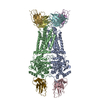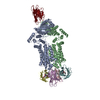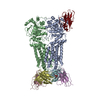+Search query
-Structure paper
| Title | Structural Basis of the Allosteric Inhibition of Human ABCG2 by Nanobodies. |
|---|---|
| Journal, issue, pages | J Mol Biol, Vol. 435, Issue 19, Page 168234, Year 2023 |
| Publish date | Aug 18, 2023 |
 Authors Authors | Rossitza N Irobalieva / Ioannis Manolaridis / Scott M Jackson / Dongchun Ni / Els Pardon / Henning Stahlberg / Jan Steyaert / Kaspar P Locher /   |
| PubMed Abstract | ABCG2 is an ATP-binding cassette transporter that exports a wide range of xenobiotic compounds and has been recognized as a contributing factor for multidrug resistance in cancer cells. Substrate and ...ABCG2 is an ATP-binding cassette transporter that exports a wide range of xenobiotic compounds and has been recognized as a contributing factor for multidrug resistance in cancer cells. Substrate and inhibitor interactions with ABCG2 have been extensively studied and small molecule inhibitors have been developed that prevent the export of anticancer drugs from tumor cells. Here, we explore the potential for inhibitors that target sites other than the substrate binding pocket of ABCG2. We developed novel nanobodies against ABCG2 and used functional analyses to select three inhibitory nanobodies (Nb8, Nb17 and Nb96) for structural studies by single particle cryo-electron microscopy. Our results showed that these nanobodies allosterically bind to different regions of the nucleotide binding domains. Two copies of Nb8 bind to the apex of the NBDs preventing them from fully closing. Nb17 binds near the two-fold axis of the transporter and interacts with both NBDs. Nb96 binds to the side of the NBD and immobilizes a region connected to key motifs involved in ATP binding and hydrolysis. All three nanobodies prevent the transporter from undergoing conformational changes required for substrate transport. These findings advance our understanding of the molecular basis of modulation of ABCG2 by external binders, which may contribute to the development of a new generation of inhibitors. Furthermore, this is the first example of modulation of human multidrug resistance transporters by nanobodies. |
 External links External links |  J Mol Biol / J Mol Biol /  PubMed:37597690 PubMed:37597690 |
| Methods | EM (single particle) |
| Resolution | 3.04 - 3.49 Å |
| Structure data | EMDB-17537, PDB-8p7w: EMDB-17543, PDB-8p8a: EMDB-17547, PDB-8p8j: |
| Chemicals |  ChemComp-NAG: |
| Source |
|
 Keywords Keywords | MEMBRANE PROTEIN |
 Movie
Movie Controller
Controller Structure viewers
Structure viewers About Yorodumi Papers
About Yorodumi Papers









 homo sapiens (human)
homo sapiens (human)
